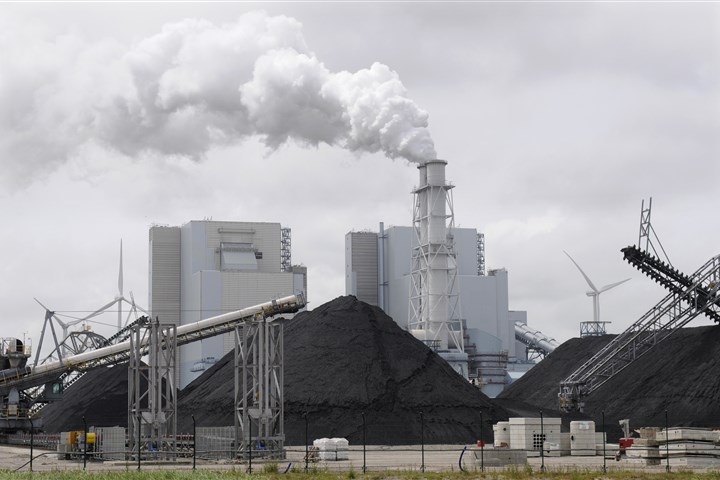Production-based greenhouse gas emissions

Since 2000, greenhouse gas emissions have fallen by 6 percent (2016), while Gross Domestic Product (GDP) has grown. In other words, there is an absolute decoupling of greenhouse gas emissions and economic growth.
| Production-based GHG emissions (index (2000=100)) | GDP (index (2000=100)) | |
|---|---|---|
| 2000 | 100.00 | 100.00 |
| 2001 | 99.52 | 102.12 |
| 2002 | 98.64 | 102.23 |
| 2003 | 98.26 | 102.52 |
| 2004 | 99.46 | 104.60 |
| 2005 | 98.32 | 106.86 |
| 2006 | 95.02 | 110.62 |
| 2007 | 96.43 | 114.71 |
| 2008 | 95.78 | 116.66 |
| 2009 | 93.37 | 112.27 |
| 2010 | 97.17 | 113.84 |
| 2011 | 93.29 | 115.74 |
| 2012 | 91.39 | 114.51 |
| 2013 | 90.20 | 114.29 |
| 2014 | 90.19 | 115.92 |
| 2015 | 93.34 | 118.54 |
| 2016 | 93.70 | 121.16 |
Production-based greenhouse gas emissions are equal to the sum of emissions of the six greenhouse gases targeted in the Kyoto Protocol (CO2, CH4, N20, CFK, HFK and SF6, in CO2 equivalents). This includes greenhouse gas emissions by resident companies which engage in production activities abroad (for example emissions by airlines and by seagoing and inland vessels). Direct emissions by households are excluded.
The issue
Combustion of fossil fuels, deforestation, but also specific agricultural activities and industrial processes are the main causes of increased greenhouse gas emissions. Elevated concentrations of greenhouse gases in the atmosphere will most likely increase global temperatures (IPCC, 2014). Climate change is of global concern because of its effect on ecosystems and socio-economic development across the planet. A key objective of green growth is therefore to improve the emission efficiency of production processes. The Netherlands has adopted the new UN Climate Agreement (Paris, 2015). The agreement is aimed at limiting global warming to well below 2 degrees Celsius, preferably 1.5 degrees Celsius.
Analysis
Since 2000, total greenhouse gas emissions from production activities have decreased. Energy savings, increased generation of renewable energy and higher electricity imports are the major causes of the decline in production-based greenhouse gas emissions. The on-going transition to a more service-based economy also contributes to lower greenhouse gas emissions. Since production of services tends to be much less emission-intensive than production of goods, it has resulted in a less emission-intensive economy as a whole. Greenhouse gas intensity improved considerably in the chemical industry, basic metal industry and in aviation, whereas little to no improvement was seen in oil refineries, waste management and road haulage.
In 2015, greenhouse gas emissions rose mainly on account of higher CO2 emissions by energy companiesdue to increased use of coal in the electricity production; in 2016, the increase was mainly on account of the chemical sector due to increased production.
International comparison
The Netherlands holds the 12th position in the 2016 ranking of 21 OECD countries in terms of greenhouse gas emissions (ranking from lowest to highest intensity). From 2008 to 2016, these OECD countries lowered their greenhouse gas intensity by nearly 20 percent on average. The Netherlands lowered its greenhouse gas intensity by approximately 6 percent.
| Production-based greenhouse gas intensity (GHG excl. F gases), 2016 (kg/mln euro) | |
|---|---|
| Sweden | 124104 |
| France | 156039 |
| Luxembourg | 167859 |
| United Kingdom | 182836 |
| Austria | 188101 |
| Italy | 208098 |
| Ireland | 210228 |
| Belgium | 225482 |
| Spain | 238609 |
| Germany | 268141 |
| Finland | 280874 |
| Netherlands | 288842 |
| Denmark | 297204 |
| Portugal | 332582 |
| Slovenia | 367075 |
| Greece | 386393 |
| Hungary | 435191 |
| Slovakia | 472436 |
| Czech Republic | 552943 |
| Poland | 785244 |
| Estonia | 1024675 |
| Source: Eurostat | |
There are several reasons why greenhouse gas intensity in our country is relatively high. Firstly, the Netherlands still largely relies on conventional energy sources such as natural gas, coal and crude petroleum products for its energy supply. The share of renewable energy sources such as wind energy, solar energy and biomass is relatively low. Secondly, industries with a high greenhouse gas intensity are heavily represented in the Netherlands, e.g. electricity companies, refineries, basic metal industry, chemical industry, road transport and livestock farming. Finally, the Netherlands exports relatively large amounts of goods (and services) to surrounding countries. Emissions released during their production are attributable to the producing country and are not counted towards emissions by the importing country.
Estonia, Poland and the Czech Republic still have relatively high emission intensities of carbon dioxide as manufacturing in these countries is still relatively energy inefficient. Electricity in these countries is also produced primarily by burning coal or lignite, resulting in high CO2 emissions. Denmark as well has a high emission intensity because maritime shipping is an important economic activity for this country. Austria, Sweden and Norway produce a substantial amount of renewable energy (hydropower) and for this reason, their economies are less emission intensive. Italy and Portugal have the advantage of needing less energy for heating of offices and shops during the winter months. This offsets their higher electricity consumption required for air conditioning in summer, thus lowering their overall emission intensity.